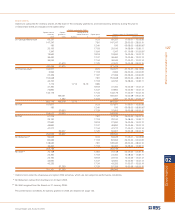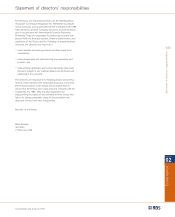RBS 2005 Annual Report Download - page 138
Download and view the complete annual report
Please find page 138 of the 2005 RBS annual report below. You can navigate through the pages in the report by either clicking on the pages listed below, or by using the keyword search tool below to find specific information within the annual report.
136
Accounting policies
1. Adoption of International Financial Reporting Standards
The annual accounts have, for the first time, been prepared in
accordance with International Financial Reporting Standards
adopted by the International Accounting Standards Board
(“IASB”), and interpretations issued by the International Financial
Reporting Interpretations Committee of the IASB (together “IFRS”)
as endorsed by the European Union (“EU”). The EU has not
endorsed the complete text of IAS 39 ‘Financial Instruments:
Recognition and Measurement’; it has relaxed some of the
standard’s hedging requirements. The Group has not taken
advantage of this relaxation and has adopted IAS 39 as issued
by the IASB. The date of transition to IFRS for the Group and
the company (The Royal Bank of Scotland Group plc) and the
date of their opening IFRS balance sheets was 1 January 2004.
The company accounts have been presented in accordance
with the Companies Act 1985.
The main differences between IFRS and previously applied
generally accepted accounting principles (“UK GAAP”) and
the effect of implementing IFRS on the Group and company
balance sheets and shareholders’ funds as at 1 January and
31 December 2004 and on the Group’s 2004 consolidated
income statement are set out on pages 210 to 218.
On initial adoption of IFRS, the Group (and the company
where relevant) applied the following exemptions from the
requirements of IFRS and from their retrospective application
as permitted by IFRS 1 ‘First-time Adoption of International
Financial Reporting Standards’:
Business combinations – the Group has applied IFRS 3
‘Business Combinations’ to business combinations that
occurred on or after 1 January 2004. Business combinations
before that date have not been restated. Under UK GAAP,
goodwill arising on acquisitions after 1 October 1998 was
capitalised and amortised over its estimated useful economic
life. Goodwill arising on acquisitions before 1 October 1998
was deducted from equity. The carrying amount of goodwill in
the Group’s opening IFRS balance sheet was £13,131 million,
its carrying value under UK GAAP as at 31 December 2003.
Fair value or revaluation as deemed cost – under UK GAAP, the
Group’s freehold and long leasehold property occupied for its
own use was recorded at valuation on the basis of existing use
value. The Group has elected to use this valuation as at 31
December 2003 as deemed cost for its opening IFRS balance
sheet. At this date, the carrying value under UK GAAP of
freehold and long leasehold property occupied for own use
was £2,391 million.
Compound financial instruments – the Group has not
separated compound instruments between liability and equity
components, as required by IAS 32 ‘Financial Instruments:
Disclosure and Presentation’, where the liability component
was not outstanding at 1 January 2004. UK GAAP did not
permit compound instruments to be separated between liability
and equity components on issue.
Derecognition – the Group has applied the derecognition
requirements of IAS 39 to transactions occurring on or after
1 January 1992.
Share based payments – IFRS 2 ‘Share-based Payment’ has been
applied to equity instruments granted after 7 November 2002.
Implementation of IAS 32, IAS 39 and IFRS 4 ‘Insurance
Contracts’ (incorporating the adoption of FRS 27 ‘Life
Assurance’) – as allowed by IFRS 1, the Group and the
company implemented IAS 32, IAS 39 and IFRS 4 with effect
from 1 January 2005 without restating the income statement,
balance sheet and notes for 2004. The Group has adopted the
Amendment to IAS 39 ‘The Fair Value Option’ issued by the
IASB in June 2005 also from 1 January 2005. The effect of
implementing IAS 32, IAS 39 and IFRS 4 on the Group and
company balance sheets and shareholders’ funds as at 1
January 2005 is set out on pages 219 to 220. In preparing the
2004 comparatives, UK GAAP principles then current have
been applied to financial instruments. The main differences
between UK GAAP and IFRS on financial instruments are
summarised on pages 212 to 214.
IFRS 1 prohibits retrospective application of some aspects of IFRS:
Derecognition of financial assets and liabilities – non-
derivative financial assets and liabilities derecognised
before 1 January 1992 (the date from which the
derecognition requirements of IAS 39 have been
implemented) under the Group’s previous GAAP have not
been recognised in its opening IFRS balance sheet.
Hedge accounting – hedging relationships of a type that
does not qualify for hedge accounting under IAS 39 are not
reflected in the Group’s opening IFRS balance sheet.
Discontinued operations and assets classified as held for sale
– the Group has applied IFRS 5 ‘Non-current Assets Held
for Sale and Discontinued Operations’ from 1 January 2005.
The Group has adopted the Amendment ‘Actuarial Gains and
Losses, Group Plans and Disclosures’ to IAS 19 ‘Employee
Benefits’ from 1 January 2004. Actuarial gains and losses are
recognised in full as they occur outside profit or loss.
2. Accounting convention
The company is incorporated in the UK and registered in
Scotland. The financial statements have been prepared on the
historical cost basis except that the following assets and liabilities
are stated at their fair value: derivative financial instruments,
held-for-trading financial assets and financial liabilities, financial
assets and financial liabilities that are designated as at fair value
through profit or loss, available-for-sale financial assets and
investment property. Recognised financial assets and financial
liabilities in fair value hedges are adjusted for changes in fair value
in respect of the risk that is hedged.
3. Basis of consolidation
The consolidated financial statements incorporate the financial
statements of the company and entities (including certain
special purpose entities) controlled by the Group (its
subsidiaries). Control exists where the Group has the power
to govern the financial and operating policies of the entity;
generally conferred by holding a majority of voting rights.
On acquisition of a subsidiary, its identifiable assets, liabilities and
Accounting policies
























